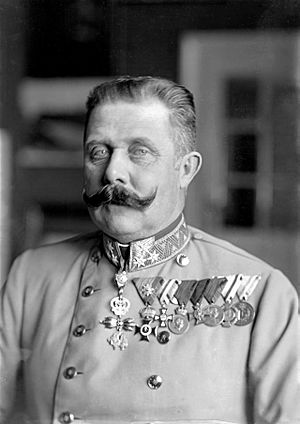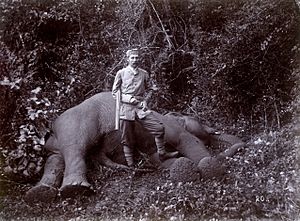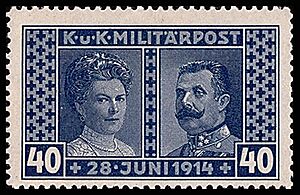Archduke Franz Ferdinand of Austria facts for kids
Quick facts for kids Archduke Franz Ferdinand |
|||||
|---|---|---|---|---|---|
| Archduke of Austria-Este | |||||

Ferdinand c. 1914
|
|||||
| Born | Franz Ferdinand Carl Ludwig Joseph Maria 18 December 1863 Graz, Duchy of Styria, Austrian Empire |
||||
| Died | 28 June 1914 (aged 50) Sarajevo, Condominium of Bosnia and Herzegovina, Austria-Hungary |
||||
| Burial | 4 July 1914 Artstetten Castle |
||||
| Spouse | |||||
| Issue |
|
||||
|
|||||
| House | Habsburg-Lorraine | ||||
| Father | Archduke Karl Ludwig of Austria | ||||
| Mother | Princess Maria Annunciata of Bourbon-Two Sicilies | ||||
| Religion | Roman Catholicism | ||||
| Occupation | Archduke of Austria | ||||
| Signature |  |
||||
Archduke Franz Ferdinand Carl Ludwig Joseph Maria of Austria (born December 18, 1863 – died June 28, 1914) was a very important person in Austria-Hungary. He was the next in line to become emperor. His murder in Sarajevo was the main event that started World War I.
Franz Ferdinand was the oldest son of Archduke Karl Ludwig of Austria. Karl Ludwig was the younger brother of Emperor Franz Joseph I. After his cousin, Crown Prince Rudolf, died in 1889, and his father died in 1896, Franz Ferdinand became the heir to the throne.
He fell in love with Sophie Chotek, who was a lady-in-waiting (a helper to a royal lady). Their marriage in 1900 was special because their children could not inherit the throne. This kind of marriage is called a morganatic marriage. Franz Ferdinand had a lot of power in the military. In 1913, he became the inspector general of the Austro-Hungarian armed forces.
On June 28, 1914, Franz Ferdinand and his wife were killed in Sarajevo. A 19-year-old named Gavrilo Princip shot them. Princip was part of a group called Young Bosnia. This assassination led to a big crisis and caused Austria-Hungary to declare war on Serbia. This started a chain of events that led to World War I just four weeks later.
Contents
Who was Franz Ferdinand?
His Early Life and Family
Franz Ferdinand was born in Graz, Austria. He was the first son of Archduke Karl Ludwig of Austria. His mother was Princess Maria Annunciata of Bourbon-Two Sicilies. When he was eleven, his cousin, Francis V, Duke of Modena, died. This cousin named Franz Ferdinand as his heir. Because of this, Franz Ferdinand became one of the richest people in Austria.
Becoming the Heir to the Throne
In 1889, Franz Ferdinand's life changed a lot. His cousin, Crown Prince Rudolf, died. This made Franz Ferdinand's father, Karl Ludwig, the next in line for the throne. When Karl Ludwig died in 1896, Franz Ferdinand became the official heir. From then on, he was prepared to take over the throne.
Even with this big responsibility, he still found time for travel. He traveled around the world between 1892 and 1893. He visited India, Australia, and Japan. He also crossed the United States before returning to Europe.
Franz Ferdinand loved to hunt. He hunted a lot, even more than other nobles of his time. He kept records of killing over 272,000 animals. About 100,000 hunting trophies were displayed at his castle in Konopiště. He also loved collecting old and rare items.
Franz Ferdinand's Military Role
His Career in the Army
Like most men in the royal Habsburg family, Franz Ferdinand joined the Austro-Hungarian Army when he was young. He was promoted quickly. He became a lieutenant at 14, a captain at 22, and a major general at 31. He never had formal training for a high command role. But he was seen as able to lead.
In 1898, the Emperor asked him to look into all parts of the military. All military groups had to share their papers with him. He also held honorary ranks in the Austro-Hungarian Navy. He became an Admiral in 1902.
Franz Ferdinand had a lot of influence over the military. He had a special office that handled military papers. In 1907, he helped choose Franz Conrad von Hötzendorf as the new Chief of the General Staff. In 1913, he became the inspector general of all armed forces. This was a very powerful position.
His Marriage and Family Life
Meeting Sophie Chotek
In 1894, Franz Ferdinand met Countess Sophie Chotek. She was a lady-in-waiting to another royal lady. Franz Ferdinand started visiting the villa where Sophie worked. They kept their relationship a secret for a while.
A Special Marriage Agreement
To marry into the royal House of Habsburg, a person usually had to be from another royal family. Sophie's family was not one of these. Franz Ferdinand loved Sophie very much and refused to marry anyone else.
Finally, in 1899, Emperor Franz Joseph agreed to their marriage. But there was a condition: it would be a morganatic marriage. This meant their children could not inherit the throne. Sophie would not have the same royal rank or privileges as her husband. She could not appear in public next to him in the same way.
Their wedding was on July 1, 1900. Emperor Franz Joseph did not attend. No other archdukes were there either. Only Franz Ferdinand's stepmother and her two daughters came. After the marriage, Sophie was given the title "Princess of Hohenberg." Later, in 1909, she became "Duchess of Hohenberg." This raised her status, but she still had to follow strict court rules. She was often separated from her husband at royal events.
Franz Ferdinand's Children
Franz Ferdinand and Sophie had three children:
- Princess Sophie of Hohenberg (1901–1990)
- Maximilian, Duke of Hohenberg (1902–1962)
- Prince Ernst of Hohenberg (1904–1954)
They also had a son who was stillborn in 1908.
His Personality and Views
What Kind of Person Was He?
Historians have described Franz Ferdinand as a strong but sometimes difficult person. He was known for being serious and not always friendly. His relationship with Emperor Franz Joseph was often tense. People said that "thunder and lightning always raged" when they talked. He was very traditional and had strong opinions.
His Political Ideas
Franz Ferdinand had clear political beliefs. He was very religious and did not like democratic ideas. He also had strong feelings against Hungarians. He believed that politics was only for the ruler, and people should obey. He often complained about Hungarian nationalism.
He wanted to give more freedom to different ethnic groups in the empire. He especially wanted to help the Czechs and the South Slavic people. But he did not feel the same way about Hungarians. He even called them "rabble" and "traitors." He worried that Hungarian nationalism could harm the Habsburg family.
He also believed in being careful with Serbia. He warned that being too harsh with Serbia could lead to war with Russia. He thought this would ruin both empires.
Franz Ferdinand was a big supporter of the Austro-Hungarian Navy. At that time, the navy was not a top priority for Austria. But he saw its importance.
The Assassination in Sarajevo
The Day of the Attack
On Sunday, June 28, 1914, Franz Ferdinand and his wife were in Sarajevo. This city was the capital of the Austro-Hungarian province of Bosnia and Herzegovina. Around 10:45 am, they were attacked. A 19-year-old named Gavrilo Princip shot them. Princip was part of a secret group called the Black Hand.
Earlier that day, another attacker had thrown a bomb at their car. But the bomb missed their car and hurt people in the car behind them. When they arrived at the Governor's house, Franz Ferdinand was upset. He asked, "So you welcome your guests with bombs!"
The Fatal Shots
After a short break, the royal couple wanted to visit the people injured by the bomb at the hospital. But the drivers were not told about the change in plans. When they realized the mistake, the cars had to turn around. As the cars stopped to turn, Princip was sitting at a cafe nearby. He saw his chance. He walked across the street and shot both Franz Ferdinand and Sophie.
He shot Sophie first, then Franz Ferdinand. Franz Ferdinand leaned over his wife, who was crying. He was still alive when people came to help. His last words to Sophie were, "Don't die darling, live for our children." His wound was very serious, and he died within minutes. Sophie also died on the way to the hospital.
The Start of World War I
The assassination of Franz Ferdinand was a major event. It, along with other issues like the arms race and nationalism, led to World War I. The war began a month after Franz Ferdinand's death. Austria-Hungary declared war on Serbia, and then other countries joined in. The assassination is seen as the most direct cause of World War I.
After Franz Ferdinand's death, Archduke Karl became the next in line for the throne. Franz Ferdinand and his wife Sophie were buried at Artstetten Castle in Austria.
Remembering Franz Ferdinand
Archduke Franz Ferdinand and his Castle of Artstetten were featured on an Austrian 10 euro coin in 2004. The coin shows the entrance to the family crypt. It also has portraits of Franz Ferdinand and his wife Sophie.
See also
 In Spanish: Francisco Fernando de Austria para niños
In Spanish: Francisco Fernando de Austria para niños
- July Crisis
- List of heirs to the Austrian throne
Images for kids








